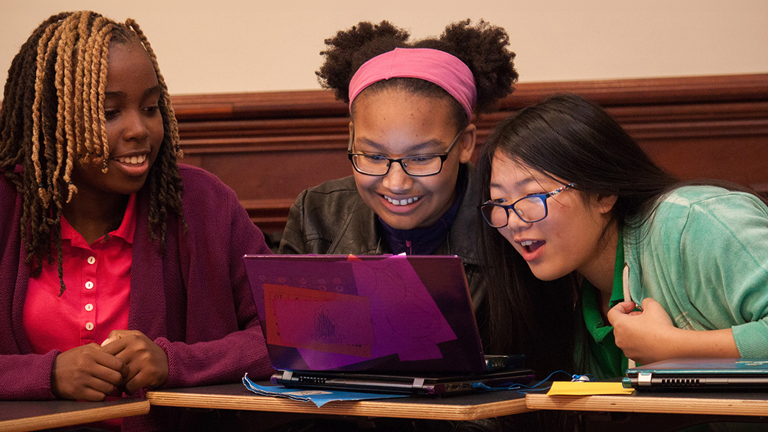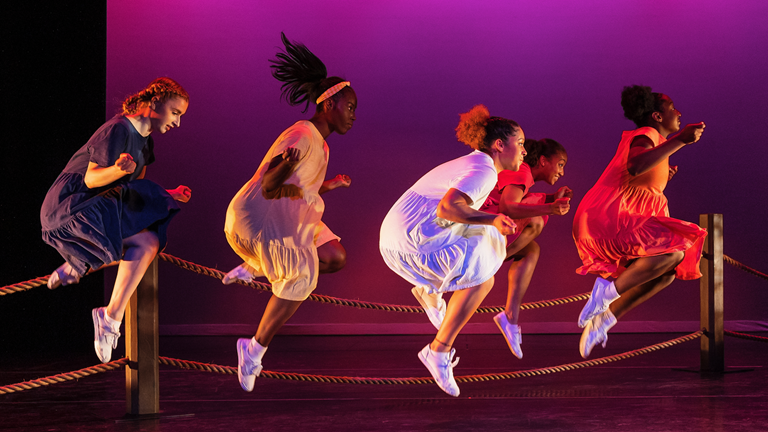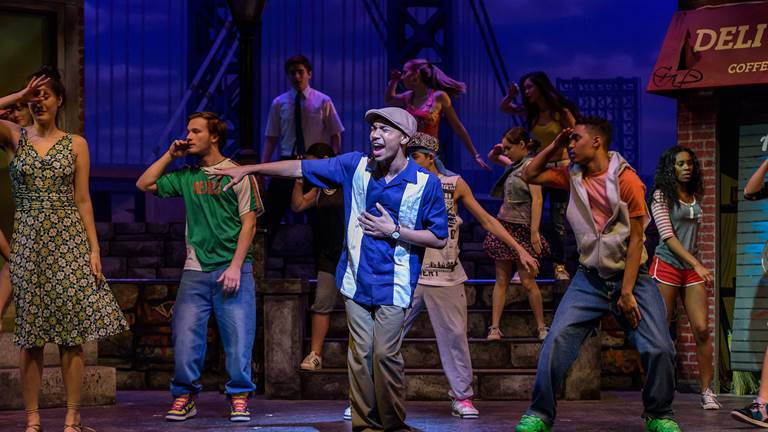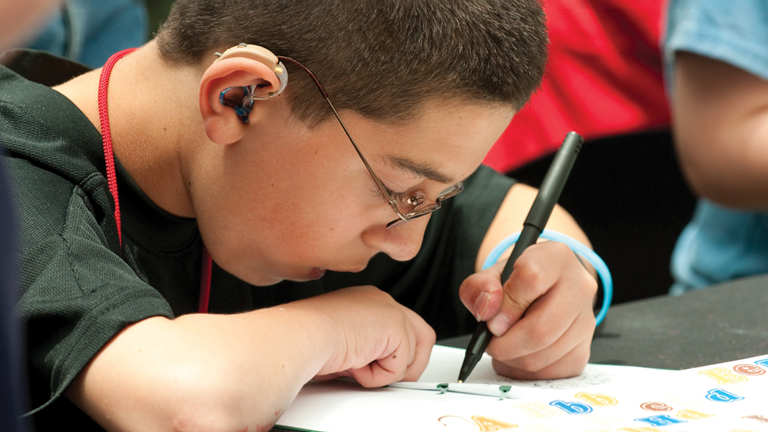Lesson Elements of Dance
In this 6-8 lesson, students will choreograph simple dances in small groups and perform for the class. Students will learn elements of dance and vocabulary by demonstrating various movements.Â
Jan. 15 - 17, 2025
Genre
Performances for Young Audiences
 View Digital Program
View Digital Program

Uncover personal truths through striking, dynamic movement.
Dance and theater merge in SHAPESHIFT’s Grey Skies Blue. Join a group of friends as they uncover personal truths through dynamic movement. Grey Skies Blue follows eight friends over the course of a summer, as they share their own stories through captivating movement, thoughtfully exploring themes of social justice, identity, addiction, and betrayal. This inspiring show features endearing characters who resonate with audiences of all ages. Comprised of solo, duet, and ensemble pieces that cover a mix of dance styles, the production’s interconnected vignettes illustrate the uplifting power of friendship when weathering life’s storms.
January 15-17, 2025
Family Theater, recommended for grades 4-12
Estimated duration is 70 minutes.
Please see the registration form for the availability of sensory-friendly performance options.
Are you a parent, caregiver, or adult looking for a listing of available public performances and times (January 17-19)? Find out more on the public show page!
Grey. Dreary. Sad. Kind of empty-like. That feeling when you look out a window and see, ugh, it’s another gloomy day. But what if you could turn that grey sky blue? Through dance, no less! Say “Hello, sunny day!” as SHAPESHIFT and its dancers tell powerful, personal stories about friendship, love, betrayal, family, and identity. Let the sunshine in as this dance company transforms “understanding” through a combination of hip hop dance and contemporary movement.
Common Core Standards
(Social and Emotional Learning)
Performance
Performers
Sound
Lighting
Projections
Audience Interaction
What to Bring
Resources
Before you watch the performance, check out this list of important moments and ideas.
After you’ve experienced the performance, consider these questions:
Just Move It
Grey Skies Blue incorporates hip hop dance into the program. Here are just a few terms you should know about hip hop moves:
To learn more about hip hop dance moves and the history of hip hop overall, visit our resource Hip Hop: A Culture of Vision and Voice.
Shaping and Shifting the Show
Choose a song whose topic or lyrics you especially like or personally relate to. Create four simple movements or “gestures” to bring the song’s story to life. What connections might you make between the words and your motions? How might your emotional motivations move with the instrumentation’s vibes? Then, keep adding steps. You’ve just SHAPESHIFTED!
For a deeper dive into how dance works as an artform, visit our Do You Wanna Dance? resource for a breakdown of the five elements of dance—body, action, space, time, and energy. (Teachers can use this media resource with the Elements of Dance lesson plan.)
The contents of this Learning Guide draw from past Cuesheet performance guide materials developed in 2017 by Marina Ruben. Updated information and feedback on this new Learning Guide was provided by Ashley Selmer, Founder and Creative Director of SHAPESHIFT.
Editors: Tiffany A. Bryant, Kaitlyn Tureaud
Producer: Tiffany A. Bryant
Accessibility Consultant: Office of Accessibility
We’re thrilled that you’ve joined us for a performance this season! We would like to hear from your students and you about the experience. After the performance, follow these steps to share feedback:
Each survey will take approximately five minutes to complete. The results will be used to inform future Kennedy Center Education program planning. Thank you in advance for sharing your valuable perspective!
In this 6-8 lesson, students will choreograph simple dances in small groups and perform for the class. Students will learn elements of dance and vocabulary by demonstrating various movements.Â
The elements of hip hop came together in the Bronx borough of New York City in the early 1970s. From a whole lot of nothing—and a whole lot of imagination—hip hop took form.
Want to understand how dance works? Learn the five elements that make up the foundation of this art form: body, action, time, space, and energy.
Our collection of short dance lessons will teach the moves that will let you hit the dance floor looking like a pro. From the African Dinhe, to the East Coast Swing, Charleston, Salsa or Cha Cha Cha, we've got you covered. Get your groove on!
Professional development for educators. Summer intensives for young artists. Teaching artist guided activities. Performances for young audiences. Classroom lesson plans. Arts-focused digital media.
Kennedy Center Education offers a wide array of resources and experiences that inspire, excite, and empower students and young artists, plus the tools and connections to help educators incorporate the arts into classrooms of all types.
Our current teaching and learning priorities include:
A robust collection of articles, videos, and podcasts that allow students of all ages to explore and learn about the arts online.

In-person and virtual performances, along with supporting educational content to help guide learning.

Current approaches to arts integration in the classroom, inclusion, rigor, and adopting an arts integration approach at the school and district level.

An asynchronous online course that invites educators and administrators to think about our students’ disabilities as social and cultural identities that enrich our classrooms and communities.

The Vice President of Education is generously endowed by the
Generous support for educational programs at the Kennedy Center is provided by the U.S. Department of Education.
Gifts and grants to educational programs at the Kennedy Center are provided by The Paul M. Angell Family Foundation; Bank of America; Capital One; The Morris and Gwendolyn Cafritz Foundation; Carnegie Corporation of New York; The Ednah Root Foundation; Harman Family Foundation; William R. Kenan, Jr. Charitable Trust; the Kimsey Endowment; The Kiplinger Foundation; Laird Norton Family Foundation; Lois and Richard England Family Foundation; Dr. Gary Mather and Ms. Christina Co Mather; The Markow Totevy Foundation; Dr. Gerald and Paula McNichols Foundation; The Morningstar Foundation; Myra and Leura Younker Endowment Fund; The Irene Pollin Audience Development and Community Engagement Initiatives;
Prince Charitable Trusts; Dr. Deborah Rose and Dr. Jan A. J. Stolwijk; Rosemary Kennedy Education Fund; The Embassy of the United Arab Emirates; The Victory Foundation; The Volgenau Foundation; Volkswagen Group of America; Jackie Washington; GRoW @ Annenberg and Gregory Annenberg Weingarten and Family; Wells Fargo; and generous contributors to the Abe Fortas Memorial Fund and by a major gift to the fund from the late Carolyn E. Agger, widow of Abe Fortas. Additional support is provided by the National Committee for the Performing Arts..
The content of these programs may have been developed under a grant from the U.S. Department of Education but does not necessarily represent the policy of the U.S. Department of Education. You should not assume endorsement by the federal government.